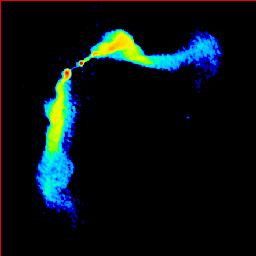 Image:
Image:
Identified with NGC 7720, the dominating
D galaxy in the cluster Abell 2634.
3C 465 is the prototypical "wide-angle tail" (WAT).
There are two features which
distinguish it from typical twin-jet FR I's like
3C 449. The more obvious is the bending of the tails
which gave the WAT class its name. A lot of work has been done to try to
understand how the tails became bent. The simplest idea, that this is
a less extreme version of the "wind-of-passage" bending found in twin-tails
like 3C 83.1B, does not work for 3C 465,
for several reasons (Leahy 1984,
Eilek et al. 1984). For instance,
this mechanism cannot explain why the bending is so irregular; in
addition, WATs tend to be
associated with central galaxies which are nearly stationary in the
centres of clusters, (although in this case NGC 7720 has a line-of-sight
velocity of 200 km/s relative to the cluster average). It is now
believed that the tails of 3C 465 are bent by large-scale gas flows
associated with the accretion of sub-clusters into the main cluster;
but similar amounts of bending in other DRAGNs appear to have quite different
causes.
The second distinguishing feature is the structure of the jets.
The jets in WATs never show the bright, smooth, "weak-flavour" structure
typical of twin-jets. Instead they go straight from the
initial inconspicuous and highly collimated "strong-flavour" structure
into a pair of "hot spots", where they suddenly brighten, bend, and broaden
into a pair of meandering tails.
These bending sites are analogous to the hotspots of classical doubles
in at least one sense, that they seem to mark the transition from jet
to lobe and from supersonic to subsonic flow, as inferred from the
much smoother brightness distribution downstream. At least for 3C 465,
it is tempting to associate the hotspots with the points at which the
jets emerge from a protecting interstellar medium into the flowing
intra-cluster medium.
This jet-hotspot-tail transition is now seen as the really important
difference between 3C 465 and twin-jet DRAGNs, since the bending does not
tell us much about the underlying physics. Because nobody wanted to invent
a new name, "wide-angle tail" now, perversely, means a DRAGN showing this
kind of transition, irrespective of whether it also shows "wide-angle" bending.
Page created: 2009 Apr 2 14:16:43
J. P. Leahy
jpl@jb.man.ac.uk
 Image:
Image: